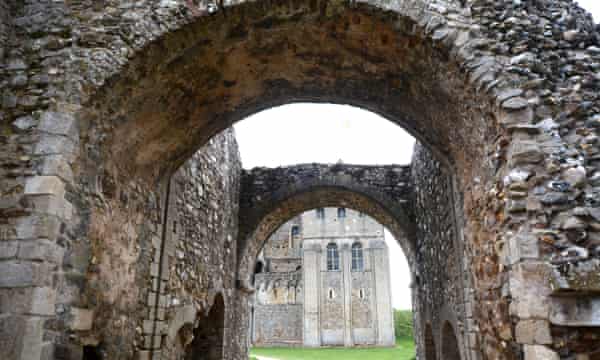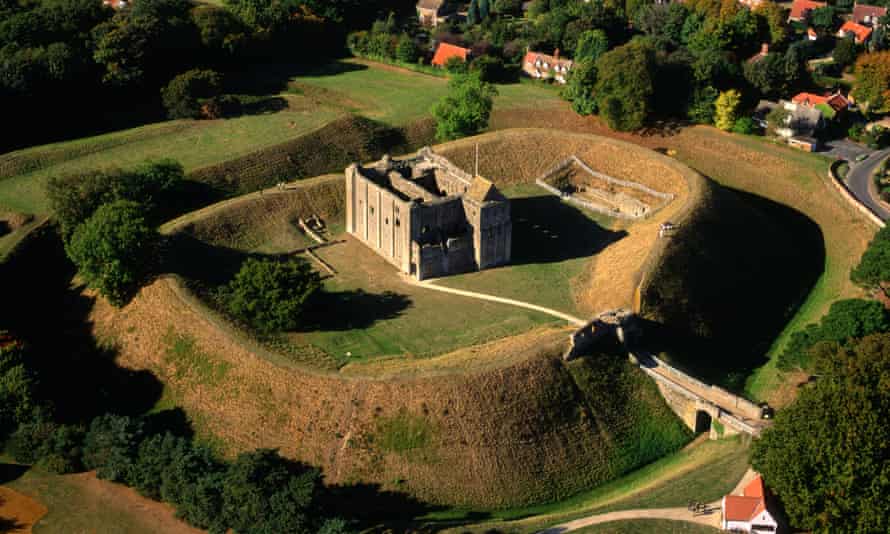
Castle Rising castle. Once you say it, there’s no obvious place to stop: “Castle-Rising-castle-rising … castle … rising … castle.” This chant would come, without fail, from the back of the car as we headed past fields of lavender, between high hedgerows, down narrow lanes leading to nowhere except, yes, Castle Rising: the tiny village with almshouses, ancient cottages and abundant gardens; the handsome church, its ornate west front heavily restored but still a thing of Norman glory; and, dominating the low landscape, the castle itself.
It wasn’t just the name that held such charm. (Rising apparently comes from Hrsing, meaning “dwellers at the brushwood place”; poetic but none too helpful.) The attraction of the magnificent 12th-century keep, earthworks and associated buildings was its sense of remoteness, of a place forgotten. On the edge of the Fens, close to the Wash, the castle sits in the mysterious flatlands of north-west Norfolk. The lost village of Babingley nearby – taking its name from the river that meanders through the marshes between castle and sea – heightens this mood of isolation.
For several summers I rented a holiday house further up the coast. At the insistence of my two daughters, we visited Castle Rising at least twice each season. These Norfolk holidays spanned the years from their childhood to beyond university age. We dragged friends there, children and grown-ups alike, willing them to feel as bewitched as we did. They all obliged, or gave a good impression of doing so. Castle Rising was our discovery, a special place we had stumbled upon after taking a wrong turning.
Now, checking the English Heritage website, I see this “secret” place is described as “one of the most famous 12th-century castles in England”. It may well be, but those with local knowledge aside, no one I know has ever heard of it – unless they have a fascination with the treacherous Isabella, “She-wolf of France” (1295-1358). The rebellious queen, wife of Edward II of England, was banished to Castle Rising, living out her widowhood in a lavish existence of hunting parties and feasting in the grand hall. Her widow’s weeds were made of silk and gold, and adorned with pearls and rubies in their hundreds. Months before her death, in the nick of time you might say, she gave it all up to become a nun, leaving Castle Rising to her grandson, the Black Prince.
The audio guide, an aid we would normally have shunned, told us all this in vivid detail, to the accompaniment of rousing medieval music. (Christopher Marlowe’s 1592 play, Edward II, made into a film by Derek Jarman with Tilda Swinton as Isabella, offers a more sophisticated take.) We never tired of it, and knew the text by heart. I’m not sure the children were quite as interested in the Plantagenet monarchy as I was, having the medieval history bug, but it appealed to their fantasy.
Battle reenactments take place there regularly, complete with colourful pavilions and flags, but we were not tempted. We loved, instead, the emptiness and silence: hot days, a slight breeze stirring the grass, few other people around. On our early visits it was possible to wander in to the castle grounds freely, paying if someone happened to be around with a ticket machine and a money satchel. English Heritage has sharpened itself up. Now there’s the inevitable shop where you can equip yourself with jousting essentials – plastic breastplates, lances, gauntlets and other paraphernalia. As keeper of the household wallet, I escaped lightly: an embossed pencil or postcard maybe, but no chivalric fakery or suits of armour were required. Most money – rather a lot, I recall – was spent in the village tea room afterwards.

I asked the children what they most remembered. Among the jumble of impressions: going across the bridge and through the grand gatehouse, racing around the moat (now only grass); rolling down banks; going up on to the high wall that surrounded the huge green bowl in which the buildings nestle. And then heading into the castle itself, up beautiful and worn stairs into hidden, blank passageways and tiny staircases, the old kitchen, the great hall, the rebuilt parts, a chapel, the musty smell of mossy stone, the glimpses through arrow-slit windows out on to the grey-green salt marshes.
In rainy summers we still went, always ill-prepared, freezing cold, soaked to the skin (reflecting my inability ever to have the right things in the car boot). On such days we had the place to ourselves, except for the couple who were always there, with vacuum flask, strong shoes and hooded anoraks, showing us how it should be done. Were they a figment of my imagination, ghosts perhaps? In this place of magic, you could believe anything.
Other historic homes associated with powerful women
Marble Hill, Twickenham
This 1720s Palladian mansion was built for Henrietta Howard, 9th Countess of Suffolk. Though historically dismissed as George II’s mistress, Howard was an extremely strong woman. She was an orphan who survived an abusive marriage to become an important influencer in political and literary circles.
Whitby Abbey, Yorkshire
The headland site of the abbey was supposed to be plagued by snakes until a nun called Hild turned them to stone and built her monastery here. This religious centre for men and women was one of the most important in Anglo-Saxon times.
Farleys House, Sussex
Photographer Lee Miller moved here with artist Roland Penrose in the 40s and it became a retreat for artists such as Pablo Picasso and Joan Miró. Works by the surrealists and modern artists cover the walls and this is also home to the Lee Miller Archive.


